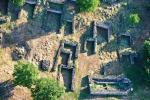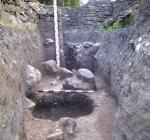Summary (English)
HOTALICH FORTRESS (Nadezhda Boteva – nadejda_boteva@abv.bg) A room, 5.80/6 m by 3.50/4.20 m in size was discovered, partly dug into the slope. An oven was explored in the room and two burned animal skeletons were found. The finds comprised over 50 loom weights, Early Byzantine sherds, a bronze coin of Arcadius, Honorius and Theodosius II, and a small fishing hook. The room was destroyed by fire during the 5th century AD. The layer with traces from fire was up to 30 cm thick. Chruch No. 3 was discovered in 1980, located in the eastern part of the lower town. It measured 12.80 m by 5.80 m and was built in rubble masonry. The apse was paved with stone slabs and a fragment from a marble Roman funerary stele was used for the altar table. There were stone benches in the church, constructed along its longer walls. During a reconstruction, the church space was narrowed from the north with an additional longitudinal wall. The finds comprised Mediaeval sherds, an arrowhead, an iron fibula and fragmentary frescoes. A wall 55 cm thick, constructed in rubble masonry, was discovered under the floor of the apse. A midden pit was discovered close to it, containing a fragment from a bronze candlestick and two Latin imitative copper coins: the first one with a large face value of the Type O minted in 1204 – 1261 and the second with a small face value of the Type A minted during the 1220s – 1240s. Chruch No. 3 was built not before 1250. The cemetery of the church appeared in the same time. The church was constructed over an earlier room and a synchronous midden pit of the first half of the 13th century. Church No. 1 situated in the western part of the lower town was burned in the middle of the 13th century and this might have been the reason for the subsequent construction of Church No. 3.
- Nadezhda Boteva - Museum of History – Sevlievo
Director
Team
Research Body
- Museum of History – Sevlievo






![Download [PDF]](/excavation/skins/fasti/images/results/download_sml.png)
